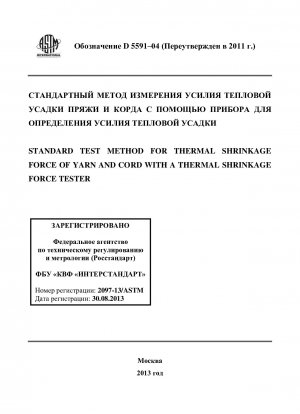ASTM D5591-04(2011)
Standard Test Method for Thermal Shrinkage Force of Yarn and Cord With a Thermal Shrinkage Force Tester
- Standard No.
- ASTM D5591-04(2011)
- Release Date
- 2004
- Published By
- American Society for Testing and Materials (ASTM)
- Status
- Replace By
- ASTM D5591-04(2016)
- Latest
- ASTM D5591-22
- Scope
This test method may be used for the acceptance testing of commercial shipments of yarns and cords.
If there are differences of practical significance between reported test results for two laboratories (or more), comparative tests should be performed to determine if there is a statistical bias between them, using competent statistical assistance. As a minimum, test samples should be used that are as homogeneous as possible, that are drawn from the material from which the disparate test results were obtained, and that are randomly assigned in equal numbers to each laboratory for testing. Other materials with established test values may be used for this purpose. The test results from the two laboratories should be compared using a statistical test for unpaired data, at a probability level chosen prior to the testing series. If a bias is found, either its cause must be found and corrected, or future test results for that material must be adjusted in consideration of the known bias.
Experience shows that yarns or cords on would packages, usually being under tension, exhibit a contraction in length (and a resulting increase in linear density) when removed from the package and allowed to relax over a period of time at room temperature. Consequently, it they are tested without being allowed to relax, they will register higher thermal shrinkage force values as the relaxation shrinkage will be incorrectly included as the thermal shrinkage force.
Retractive forces vary widely by polymer type, being almost nil within aramids and significant within most nylons. For example, the exposure of untensioned skeins of nylon yarn or cord to 95 to 100 % relative humidity at room temperature for two days and reconditioning under standard laboratory conditions will cause most of the length change that is possible at room temperature to occur within a sample. This reduction in length is accompanied by some lowering of thermal shrinkage force.
The thermal shrinkage force of nylon, polyester, and aramid fiber is related to the polymer of origin and its manipulation in processing. Thermal shrinkage force measurement can be used to control product uniformity.
The level of thermal shrinkage force is critical in the user's subsequent operations, such as the drum-set (original length of cord) required to build a tire of a particular size.
The thermal shrinkage force is critical to the final shape and size of fiber-reinforced articles. For example, thermal shrinkage force affects the final size of V-belts and their ability to maintain tension during their operation.
This test method is in agreement with the nominal procedures of Methods D885 for the determination of thermal shrinkage force in yarns and cords.
Shrinkage force is measured while the specimen is within an oven at a specified temperature and after a specified length of time.
1.1 This test method covers preparation and procedures to measure the thermal shrinkage force of yarns and cords in air.
1.2 This test method is applicable to measurement of the thermal shrinkage force of yarns and cords whose shrinkage force at 180 ± 2°C (355 ± 4°F) in air does not exceed 20 N (4 lbf). This test method is applicable to nylon, polyester, and aramid yarns and cords within the applicable range of thermal shrinkage force, as well as to comparable yarns and cords from other polymers.
1.2.1 Test specimens may be taken from yarn or cord packages, or retrieved from fabrics.
1.3 The values stated in SI units are to be regarded as the standard. The values given in parentheses are for information only.
1.4
ASTM D5591-04(2011) Referenced Document
- ASTM D123 Standard Terminology Relating to Textiles
- ASTM D2258 Standard Practice for Sampling Yarn for Testing
- ASTM D6477 Standard Terminology Relating to Tire Cord and Fabrics
- ASTM D885 Standard Test Methods for Tire Cords, Tire Cord Fabrics, and Industrial Filament Yarns Made from Man-Made Organic-Base Fibers
ASTM D5591-04(2011) history
- 2022 ASTM D5591-22 Standard Test Method for Thermal Shrinkage Force of Yarn and Cord With a Thermal Shrinkage Force Tester
- 2004 ASTM D5591-04(2016) Standard Test Method for Thermal Shrinkage Force of Yarn and Cord With a Thermal Shrinkage Force Tester
- 2004 ASTM D5591-04(2011) Standard Test Method for Thermal Shrinkage Force of Yarn and Cord With a Thermal Shrinkage Force Tester
- 2004 ASTM D5591-04 Standard Test Method for Thermal Shrinkage Force of Yarn and Cord With a Thermal Shrinkage Force Tester
- 2002 ASTM D5591-02 Standard Test Method for Thermal Shrinkage Force of Yarn and Cord With a Thermal Shrinkage Force Tester
- 1998 ASTM D5591-98a Standard Test Method for Thermal Shrinkage Force of Yarn and Cord Using the Testrite Thermal Shrinkage Force Tester
